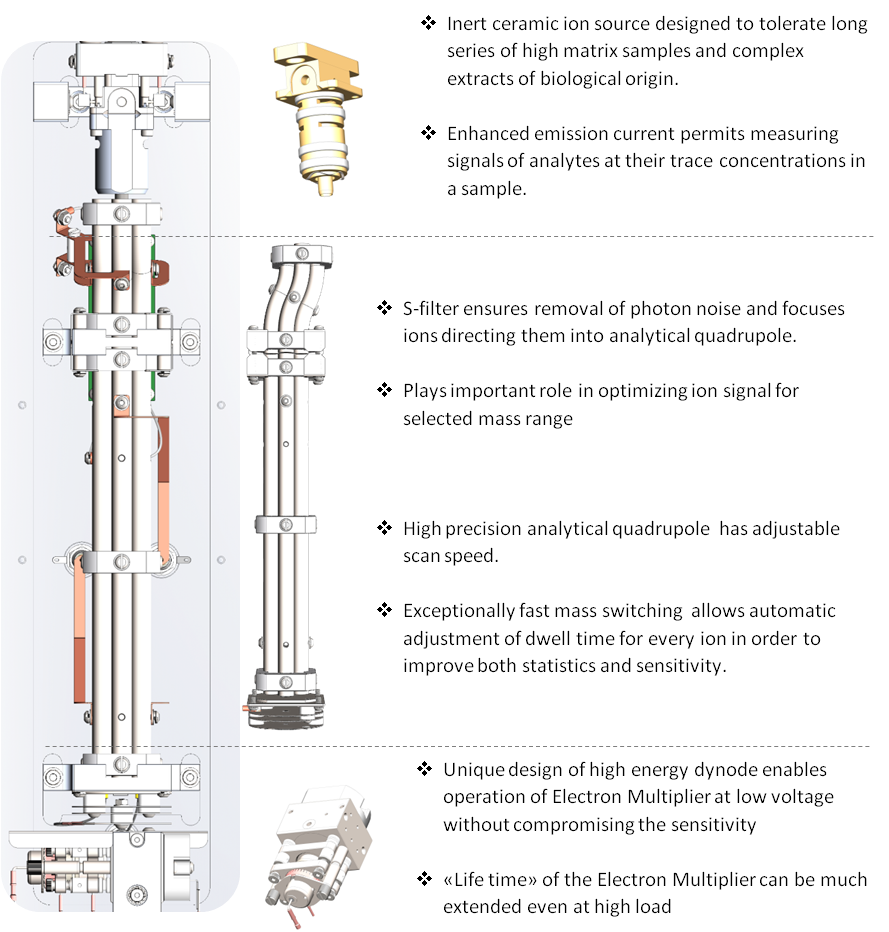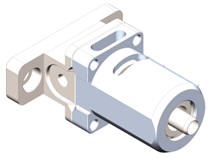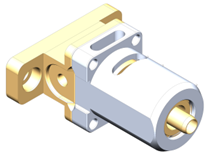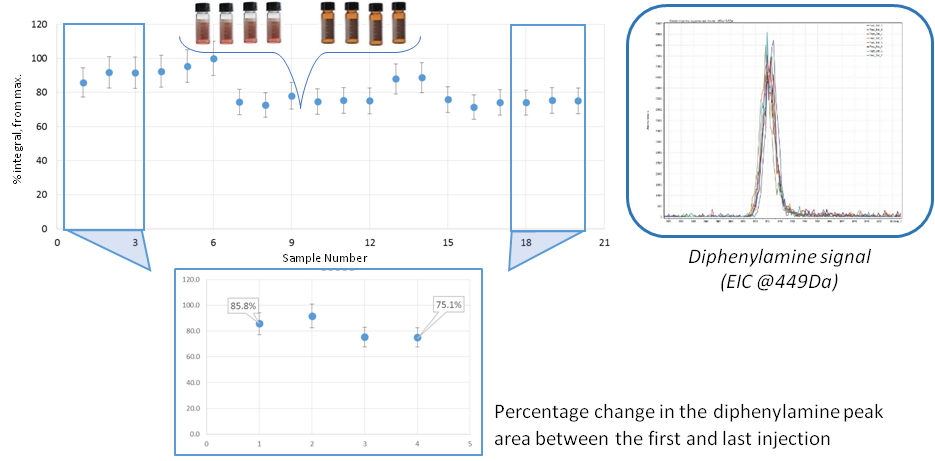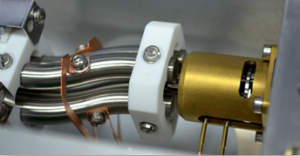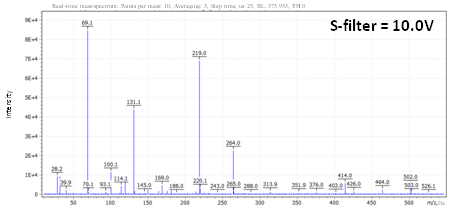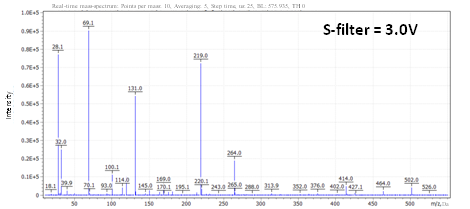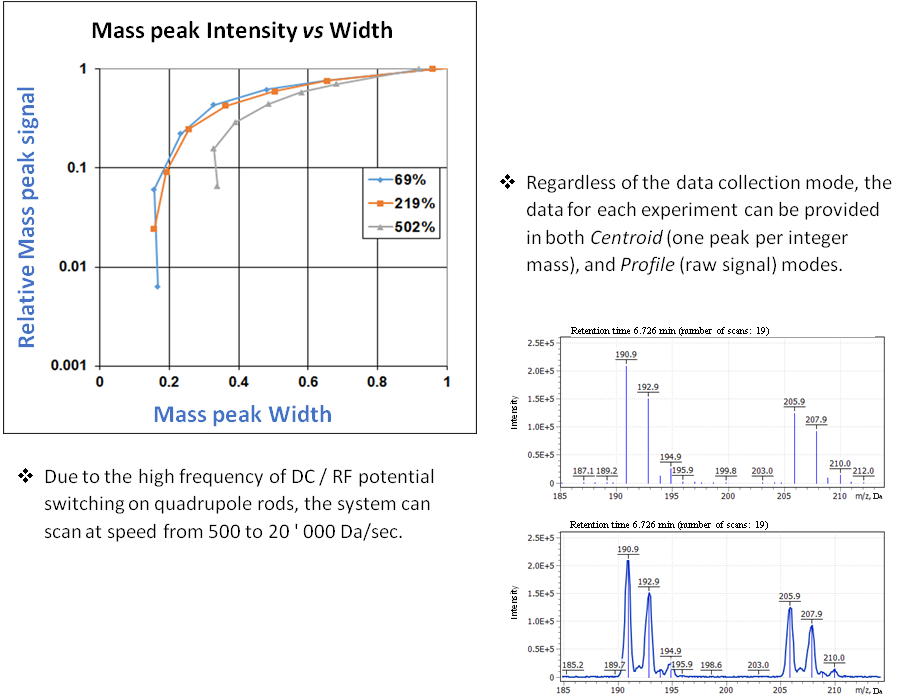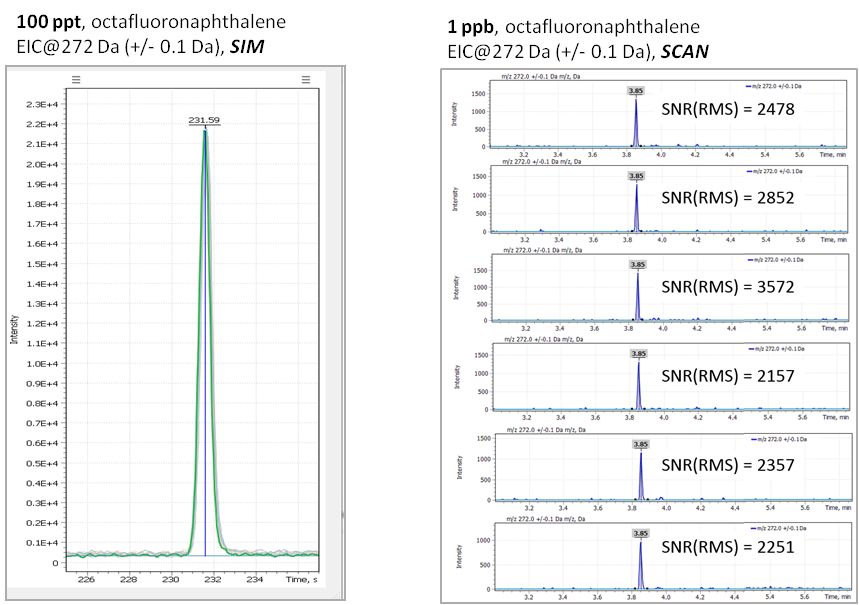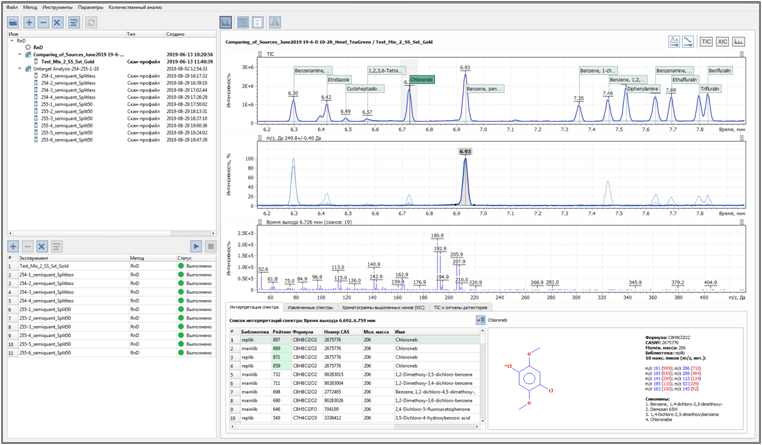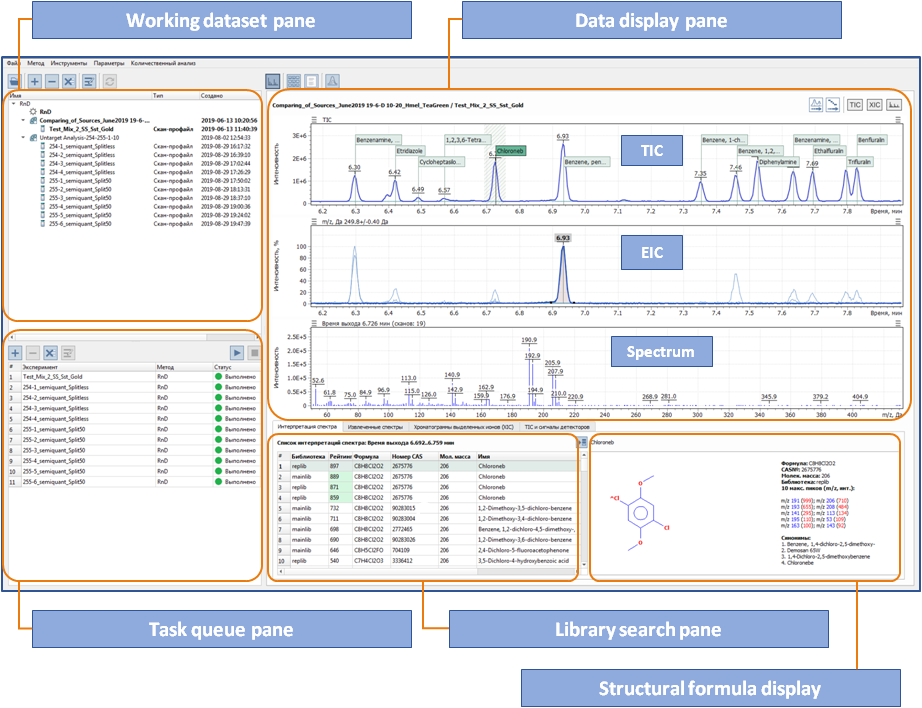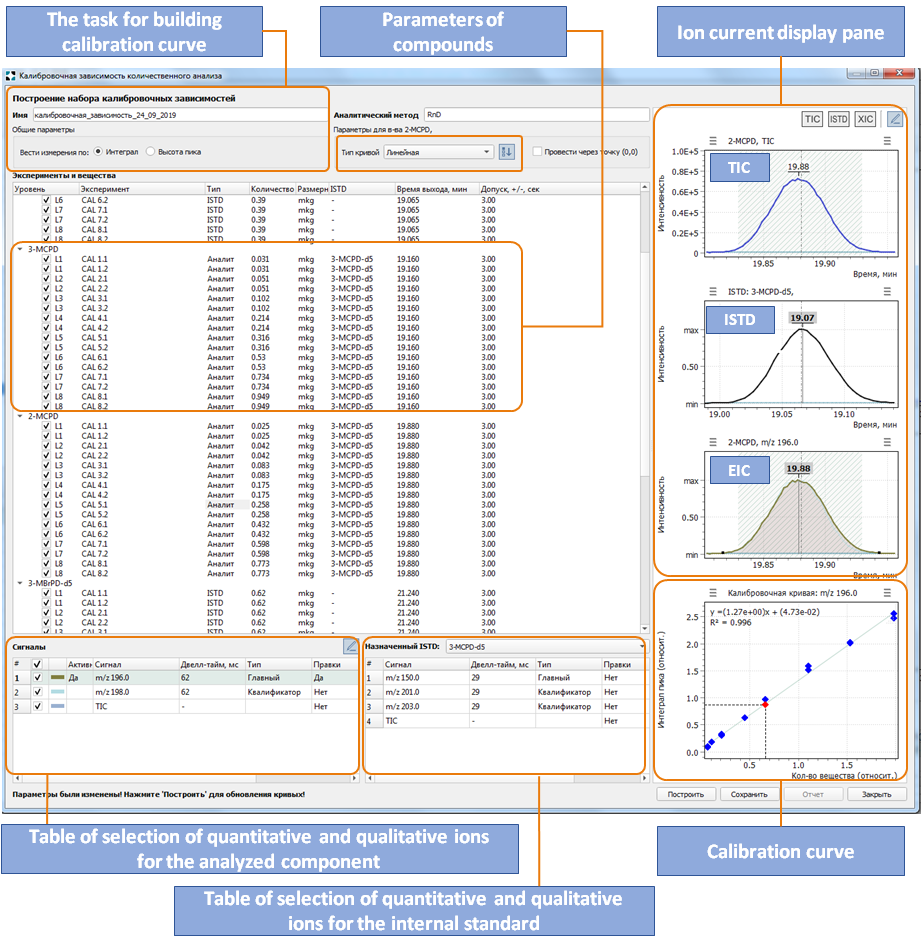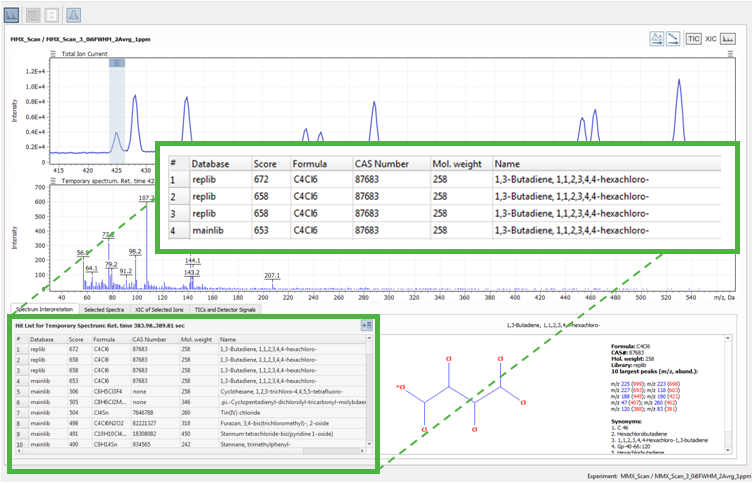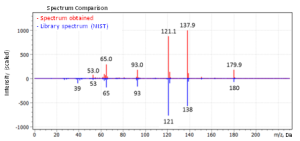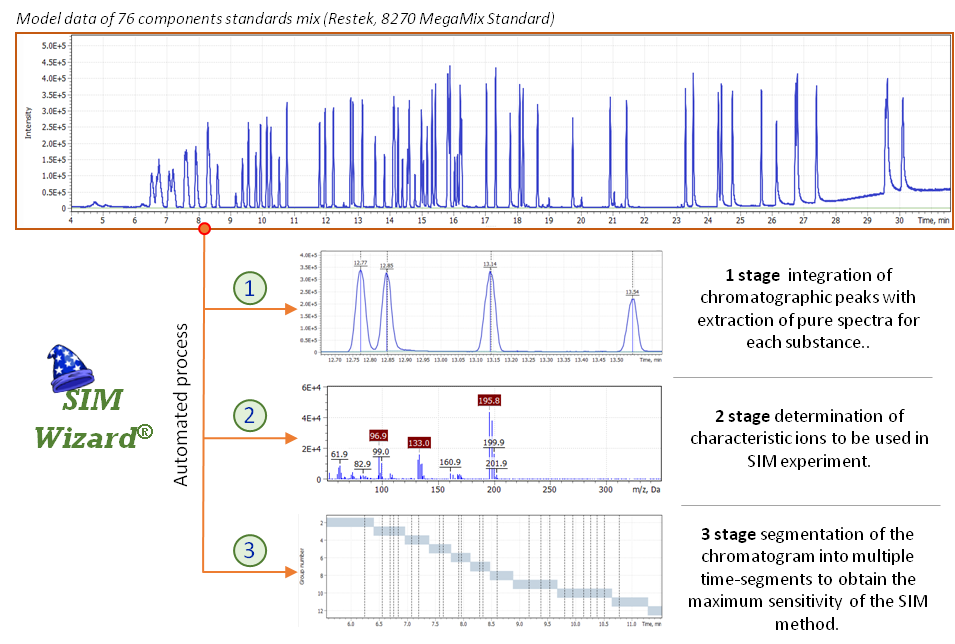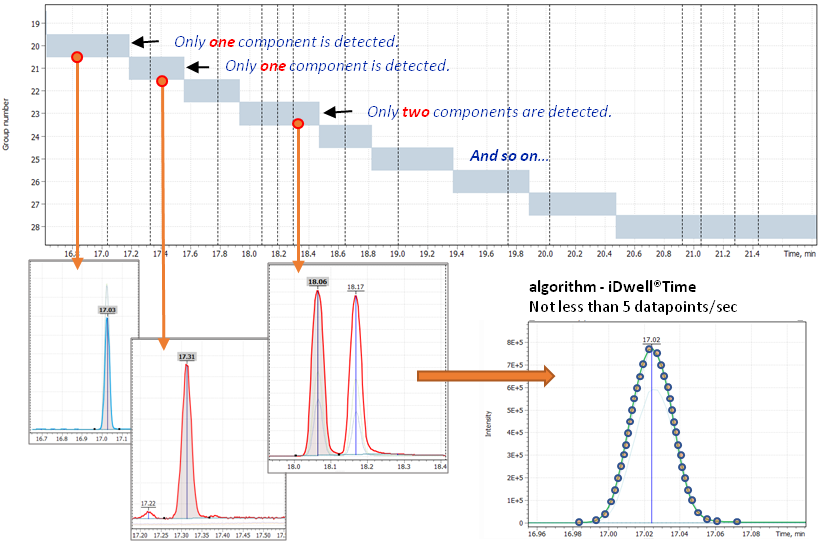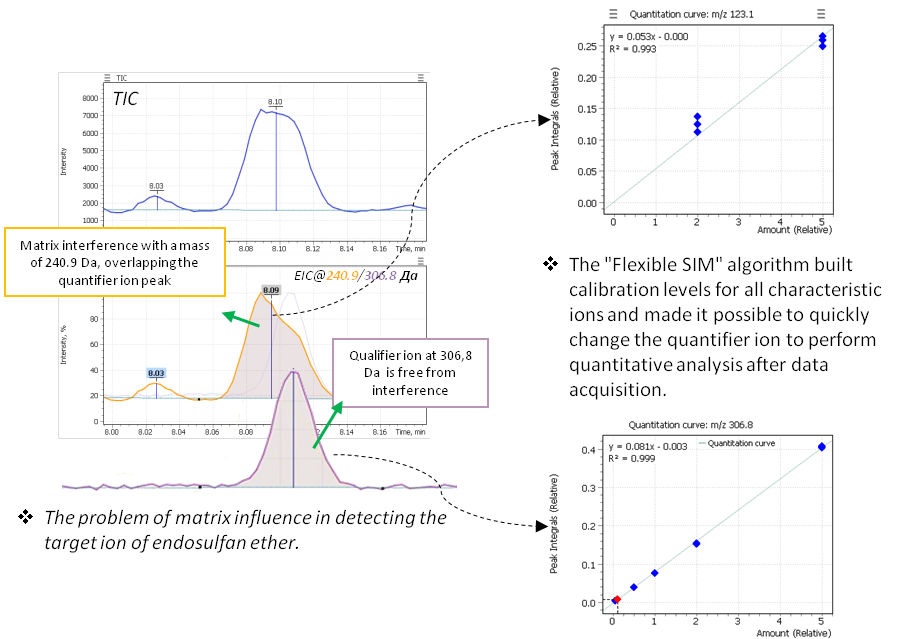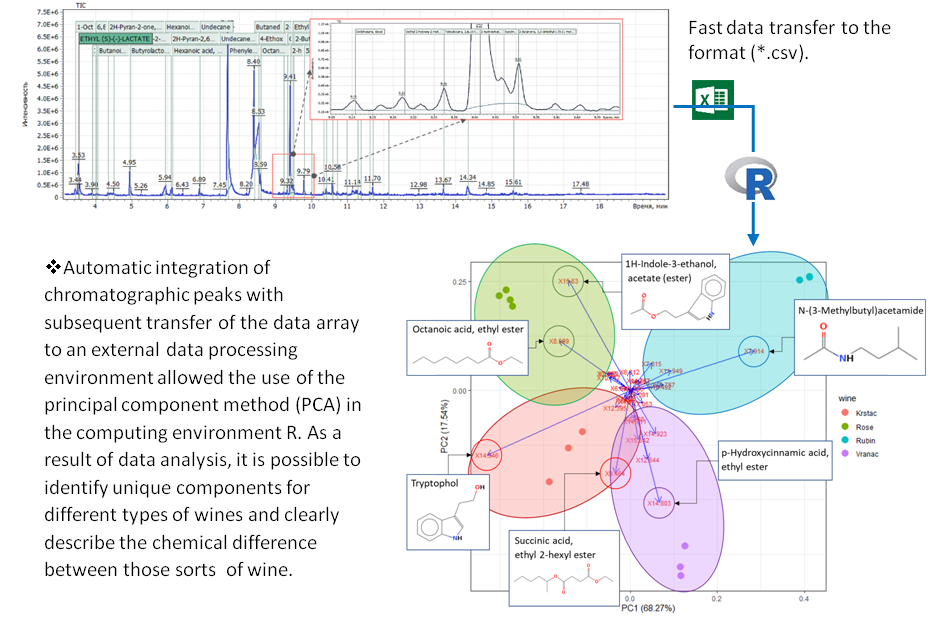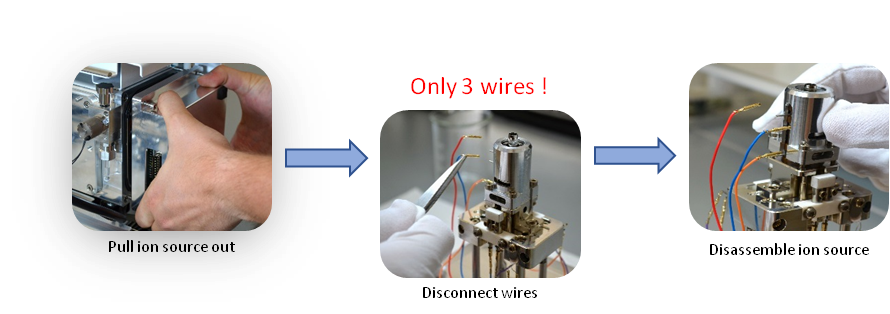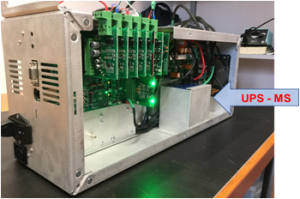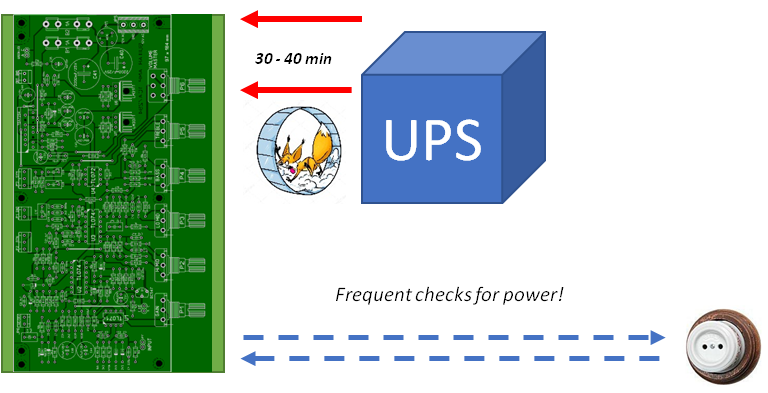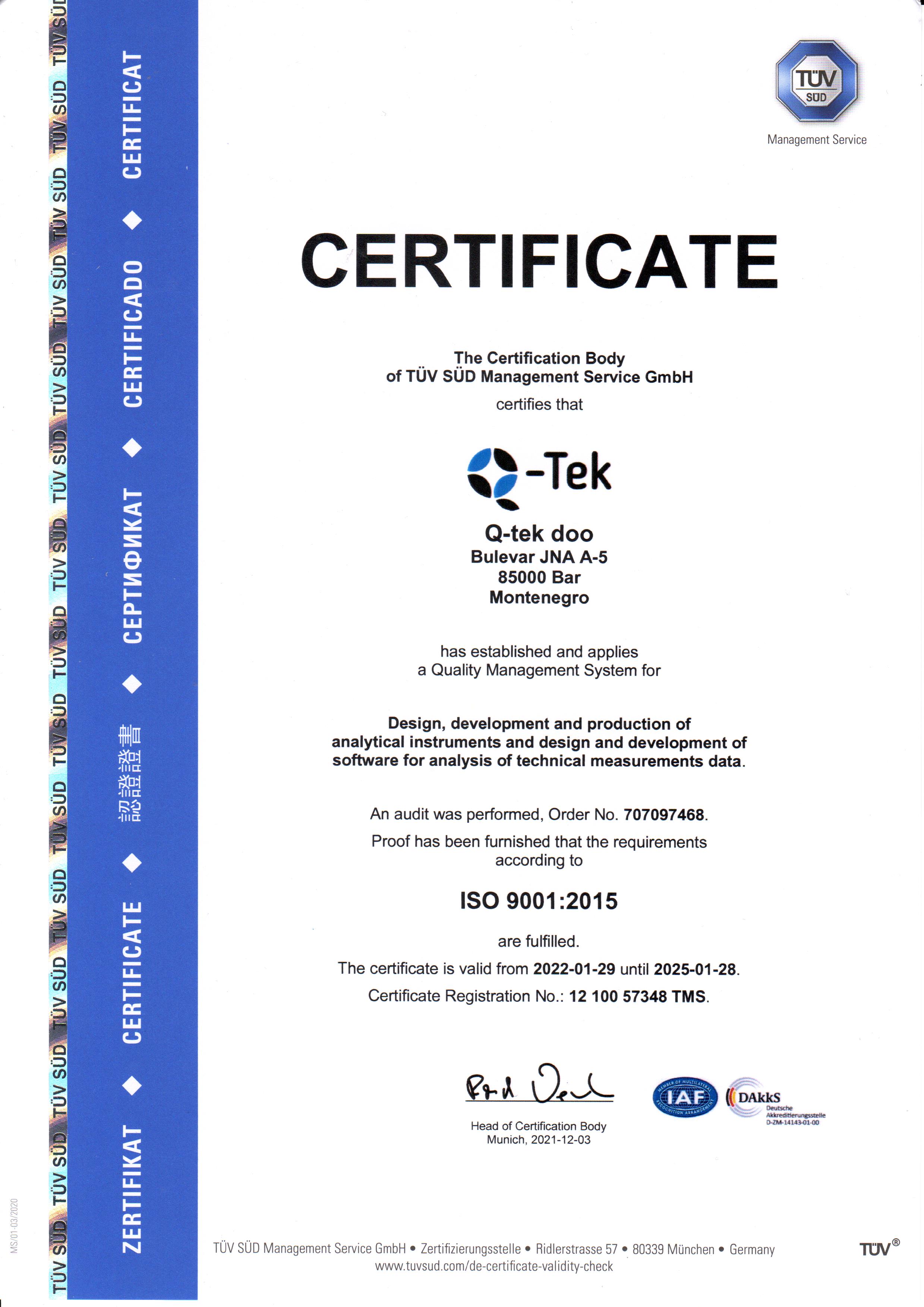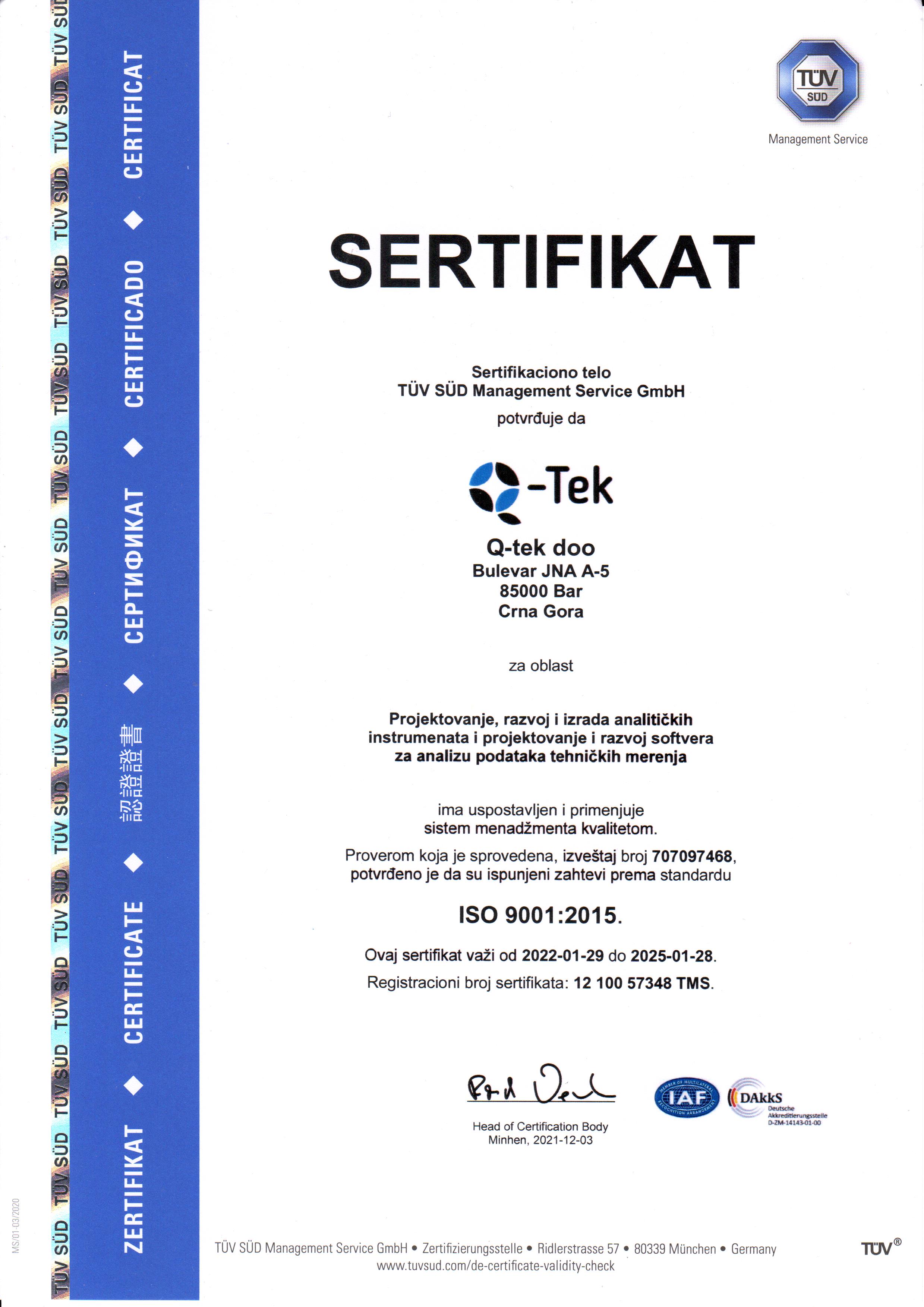Single-Quadrupole GC/MS
Q-Tek GC-MS – the classical principles of mass-spectrometry expressed with innovative technologies.
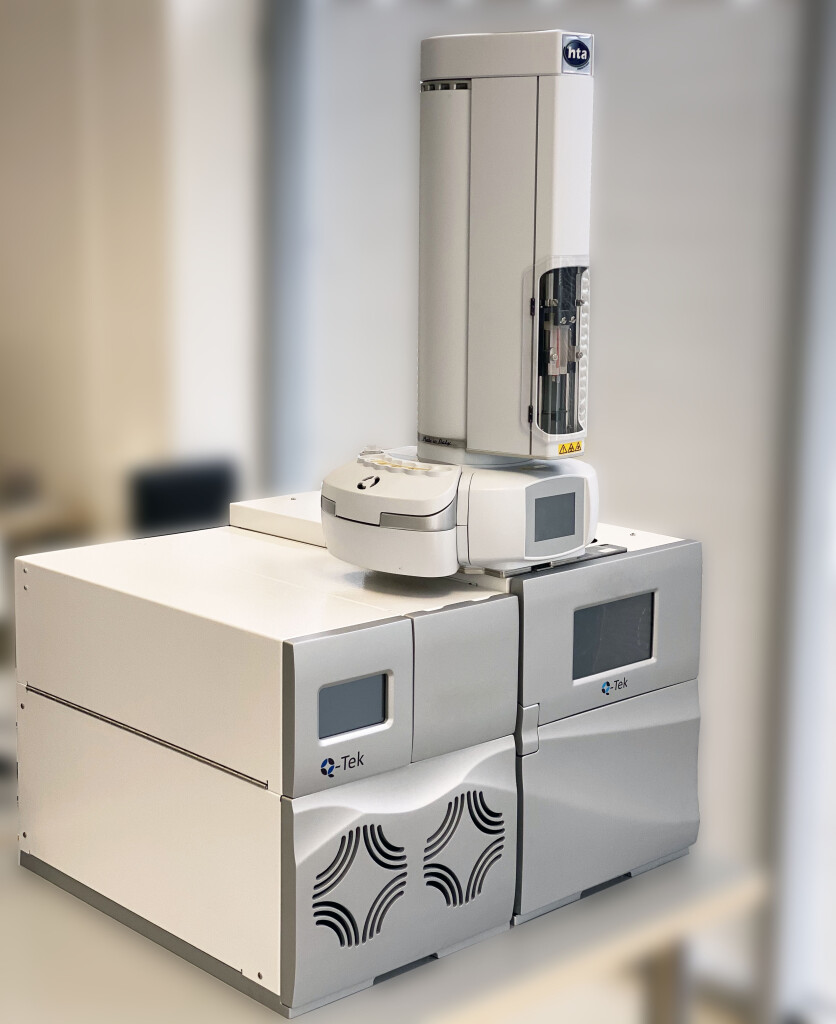
Highly efficient system configuration to achieve maximum sensitivity
Innovative design solutions and modern materials and technologies allowed us to develop the novel type of inert ion sources
Ion sources operate at high emission current values, which allows for high ion currents. At the same time, the high purity and quality of the materials used, as well as new technological solutions make the ion source reliable and inert even to complex biological extracts.
Conventional ion source Inert ion source
- The unique isothermicity of the source ensures high ionization efficiency of non-volatile compounds, which provides an improved response for active and late-eluted compounds;
- The innovative use of ceramic material ensures that the source is inert even to complex biological matrices. This source requires less maintenance than conventional ion sources;
- A special layer of ceramic inner surface ensures high ionization efficiency of nitro compounds.
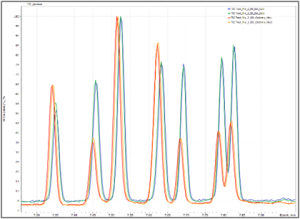 Trifluralin compound response for the inert source.
Trifluralin compound response for the inert source.
Trifluralin compound response for the conventional ion source.
Stability of the ion current signal during multiple injections of complex biological matrix extract of fermented milk products with a high fat content.(App Note-11/2019GCMS)
Stability of ion signals is one of the most important parameters when working with mass spectrometric detectors in a complex matrix. Usually Electron Impact ion source prone to contamination is the most vulnerable element of the system, as the design of such sources is usually “closed type”. This design makes it possible to further concentrate the sample components in the source and thus achieve the level of trace concentrations.
The inert source of the GC-MS system is resistant to samples with a high content of matrix components and does not require frequent maintenance. To demonstrate excellent robustness of the ion source we used samples from a routine laboratory. We repeatedly injected extracts of cottage cheese and butter into GC-MS, followed by injection of diphenylamine standard. Comparison of the diphenylamine peak areas at the beginning of the experiment and after more than a hundred injections of fermented milk extracts indicates the absence of contamination of the ion source.
The results of the study demonstrate the stability of the ion current peak area over many infections.
Using hydrogen as a carrier gas
Usually, in gas chromatography-mass spectrometry, helium is used as a carrier gas.
However, over recent years, the use of hydrogen as an alternative carrier gas has increased due to the high and growing cost of helium, the inconveniences of dealing with gas bottles and a number of other significant advantages.
The advantages of using hydrogen are as follows:
- the speed of chromatography significantly increases (due to the higher linear velocity of the hydrogen carrier gas, compared with helium);
- therefore, the time for one analysis is reduced;
- hydrogen can be produced by a hydrogen generator;
- Besides, hydrogen is known to maintain emission properties of the electron multiplier, thus extending its lifetime.
The design of the ion source of the mass detector is optimized for both helium and hydrogen as a carrier gas and does not require modification or replacement of any ion source hardware components. Thorough testing have shown excellent reliability, safety and reproducibility of the MS-detector when using hydrogen as a carrier gas.
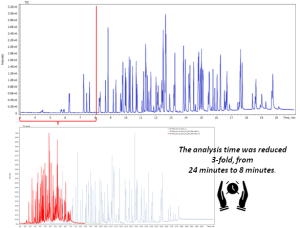 Using hydrogen as a carrier gas, made it possible to successfully separate more than 75 pesticide compounds in less than 8 minutes, with the sensitivity of the method at 5 ppb (App Note-11/GCMS2019)
Using hydrogen as a carrier gas, made it possible to successfully separate more than 75 pesticide compounds in less than 8 minutes, with the sensitivity of the method at 5 ppb (App Note-11/GCMS2019)
S-filter provides complete removal of photon noise and reliable focusing of the ion beam into a quadrupole mass filter
In all GC-MS systems, electron impact ion sources use filaments, which in addition to emitting electrons, also form neutral particles such as photons. The presence of such particles for a mass spectrometric detector result in high background noise in the spectrum.
The S-filter forms a retaining electric field that allows deflecting charged particles from the trajectory and thus filtering neutral particles away. Thus, only charged particles, in particular the ions formed in the ion source, go into the quadrupole and then onto the detector.
Changing the voltage on the S-filter allows operator to further adjust signal intensity over different ranges of analyzed masses.
1. During the auto-tuning process, the algorithm automatically detects points of optimal S-filter voltage.
2. Say, when measuring over typical mass range, the S-filter can push low residual gas signals, thus eliminating distortion of the resulting spectrum in the case of dirty carrier gas. While the mass response ratios in the spectrum are preserved, as shown in the figures below. This feature allows operator to get a high score of library match of the studied spectrum and confident identification of unknown analyte.
Autotune S-filter parameter
Manual S-filter adjustment to raise signal intensity over mass range of residual gases
High-precision quadrupole filter design for separating ions by their mass-to-charge ratio
The quadrupole is formed by four rods, which are located symmetrically relative to the common Central axis.
The utmost precision fabrication of the quadrupole rods and the proven technology of precise assembly, permit to hold a high-intensity ion beam even with a mass-peak width below 0.4 Da.
The peak intensity varies insignificantly up to a mass peak width of 0.4 Da.
System Specifications
System technical specifications:
- Mass range: 2 – 1200 amu.
- Scan rate: upto 20000 amu/sec
- SCAN sensitivity: SNR > 1500:1 (OFN@272)
- SIM sensitivity: IDL < 10 fg (OFN@272)
- Linear dynamic range: 5^106
- Mass axis stability: < 0,1 amu/48 hrs
- Turbomolecular pumps: 75 L/sec or 300 L/sec
- GLP features: OQ/IQ/PV protocols available
Easy-to-use, state-of-the-art software with highly automated auxiliary algorithm architecture
- “Easy to use” – is a fundamental principle that has been used in development of software.
- The software combines many automatic algorithms for configuring ion scanning methods to achieve maximum sensitivity and quality of data, as well as many automatic algorithms for processing the acquired data.
- The software works under Windows, Linux, and Apple operating systems.
- The software is designed to be translated into different languages.
The software
«Ease of use» – is a fundamental principle that is used in the development of software. It has become a modern software product much appreciated for convenience and ease of operation, having all the necessary tools at hand on a single screen.
- Instant result of spectral library search*;
- Simultaneous use of multiple libraries
*List of search results through all libraries, with conventional matching “Score”
The software
Quick and easy procedure for building a calibration curve.
Software tools, for processing data acquired in full scan mode (SCAN)
The software package uses a variety of algorithms that enable an operator to quickly and easily review chromatograms obtained in full scan mode (Scan).
«On-line» scanning the chromatogram profile with simultaneous data matching in multiple libraries.
The software supports all known commercial libraries: NIST, Wiley, Pfleger-Maurer-Weber etc.
The feature to compare spectra “Head-to-Tail” is implemented directly in the program.
Automatic SIM method development algorithm “SIM Wizard®”
The innovative software tool “SIM Wizard®” is an algorithm for automated construction of the SIM-experiment program, based on the SCAN data from the experiment run on analyte standards.
The algorithm includes automated stages:
SIM-Library
The Operator software contains an integrated library of characteristic SIM ions for several hundred different organic compounds.
The data source for this library was both experimental data obtained from a variety of literary sources, and our own experiments. Such data can guarantee the reliability of the results obtained and the maximum sensitivity of the method. An expert level operator can edit this library, in particular, add or delete certain compounds or their relevant ions.
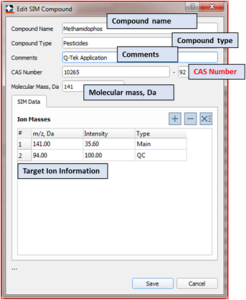 Each compound added to the SIM ion library is described in an “individual information card”. The card displays the main relevant information of the compound.
Each compound added to the SIM ion library is described in an “individual information card”. The card displays the main relevant information of the compound.
- molecular weight of the compound;
- compound name;
- compounds type;
- the unique numerical identifier of the substance-CAS.
CAS-number is used as a main reference. If the CAS number of the detected compound matches compound CAS number from the SIM library, the “SIM-Wizard°” algorithm will suggest using the library data set by default. Otherwise, the selection of target ions will be facilitated by the “SIM Wizard®” algorithm.
Algorithm for automatic calculation of analyze time for each ion in SIM mode – “iDwell®Time”
The process of developing the SIM method involves not only making a list of individual and characteristic ions for monitoring, but also setting up a strategy for scanning them.
Quality recording of a complete chromatographic peak requires at least 10 data points to be stored over the entire width of the detected peak. However, the frequency of data point collection must meet this requirement for both narrow and wide chromatographic peaks.
The software has a built-in innovative iDwell®Time algorithm, which automatically divides the chromatogram into optimal time segments of scanning, calculates the optimal dwell time for each ion to provide data collection frequency of at least 5 points/sec, thereby achieving maximum sensitivity of the method, its stability, as well as the correct algorithm for data integration (App Note-2/2018GCMS).
Innovative post-run data processing algorithm «Flexible SIM» for reliable quantification
The problem of analyzing trace amounts of organic compounds is often associated with their very low levels of concentrations in samples, a wide variety of chemical structures and strict regulations on their presence in samples, as well as natural samples matrices complexity.
The so-called “matrix effects” interfering sample matrix components impeding correct detection of the target compounds in the sample. Those matrix components are detected at retention times same a those of the analytes imposing difficulties of analyte’s correct identification and quantitation.
Software contains a “Flexible-SIM” post-processing algorithm to minimize matrix effects in complex matrix extracts by changing quantitation ions. By a mouse-click an operator can swap quantifier and qualifier ions and build and new calibration curve with a free from interference qualifier without running additional experiments.
Software includes selection of standard report templates:
- Report on library search on selected spectra.
- Qualitative analysis report.
- Quantitative analysis report.
- Custom reports.
There are also many templates offered to an operator for displaying chromatograms and calibration curves based on laboratory needs and current practices.
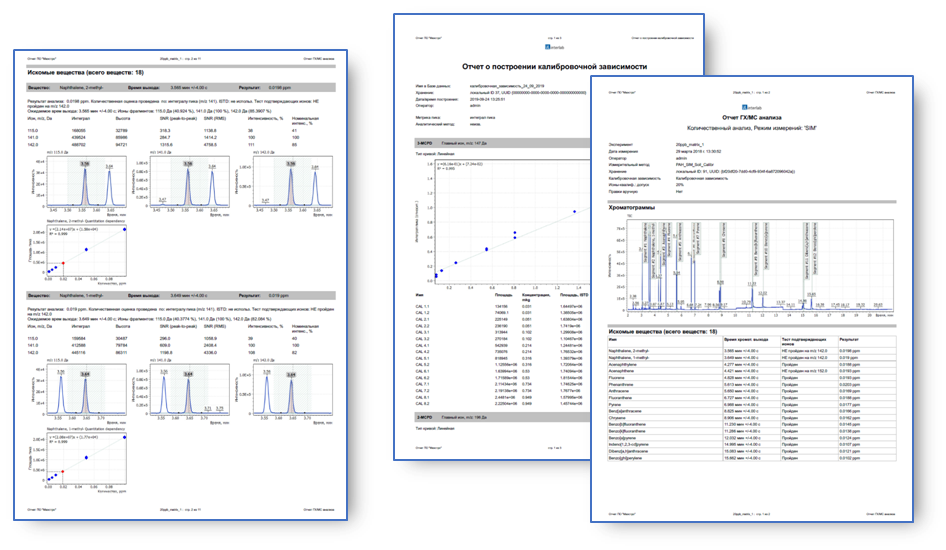 The results of quantitative and qualitative analysis can also be uploaded to *.xml format and used in any other external data processing module. In particular, an operator can export experimental GC-MS data to Excel and combine it with the data obtained with another technique for a personal report or comparison.
The results of quantitative and qualitative analysis can also be uploaded to *.xml format and used in any other external data processing module. In particular, an operator can export experimental GC-MS data to Excel and combine it with the data obtained with another technique for a personal report or comparison.
Transfer data to any external software for further processing
Often, the results of the obtained mass spectrometric data must be transferred to any other external software module for further processing.
The integration results in the software can be easily exported to any external software for further processing while charts and plots are as easily exported to text editors. This feature is particularly very useful for writing scientific articles, publications, as well as calculating the “raw” data in any other external specialty software.
Easy operation and easy maintenance
The MS-detector user maintenance includes procedures for cleaning the ion source, replacing the filaments, and replacing the electron multiplier. All procedures are illustrated in detail in the “user Guide”, as well as in video lessons.
The ion source is accessed from the front side of the system, no need to swing open the entire analytical flange for ion source maintenance.
GC-MS has a number of built-in remote and self diagnostics features, designed to autonomously maintain system operation at maximum performance level or to restore system performance at low cost. They make a requirement for extensive training of supporting personnel redundant.
GC-MS keeps logging of all operator actions and system parameters during each run.
- Monitored parameters includes:
- Number of injections through septa;
- Number and total duration of runs;
- Working time of each filament;
- The value of the vacuum in the fore-vacuum line and others.
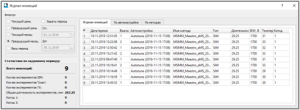 As soon as any threshold value of the monitored parameters is reached, the system displays a warning message.
As soon as any threshold value of the monitored parameters is reached, the system displays a warning message.
Maintaining uninterrupted power supply in the event of a power outage
In the event of a sudden power outage in the laboratory, the most critical components at risk and most likely to be damaged are the electronic boards of the mass detector, the high-vacuum pump, and filaments.
- Mass spectrometric detector has so called UPS-MS a built-in uninterruptible power supply to protect the entire system from spikes, surges and power outages.
- The UPS-MS maintains the autonomous operation of electronics in event of power failure. Every 5-10 seconds, clever UPS-MS algorithm checks for power at the mains. If the power is back within 30-40 minutes the system restores its status and parameters and goes back into operation.
- If there is no power back in 40 minutes, all electronics and vacuum system (especially turbomolecular pumps) will be turned off and shut down in a safe mode.
UPS-MS operating principles

